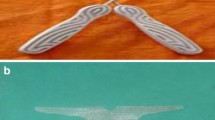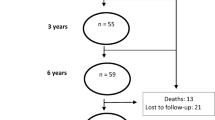Abstract
The objective of this study was to compare mesh erosion after transvaginal repair of cystocele using Gynemesh or Gynemesh-Soft mesh. We retrospectively analyzed 138 consecutive cases of transvaginal repair of cystocele using synthetic mesh. The study endpoint was the pathological evidence of vaginal erosion. Multiple logistic regression was used to determine independent predictors of vaginal erosion. One hundred and thirty eight women (ages 30–83 years) with cystocele between October 1999 and October 2004, from a French University Hospital, participated in this study. Cystocele repair was performed in all patients according to the technique of tension-free polypropylene mesh. The median follow-up was 32.1 months (range 7.5–59.9) in the Gynemesh group and 7.1 months (range 1–21.9) in the Gynemesh-Soft group. Vaginal erosion was reported in 27 (20%) of the patients. Anatomically, the success rate was 95% (131/138). There was no statistically significant difference between the Gynemesh and the Gynemesh-Soft meshes [the rate of vaginal erosion of the mesh was 16% (15/89) vs 24% (12/49), respectively, p=0.39]. Univariate analysis only identified age class as factor significantly associated with the probability of vaginal erosion. Multivariate analysis revealed that age class is an independent predictive factor of vaginal erosion (age > 70 years, odds ratio (OR) 3.6, 95% confidence interval (CI) 1.3–9.7, p=0.010). Furthermore cystocele stage > 2 (Baden and Walker classification) is a protective factor against vaginal erosion (OR 0.3, 95% CI 0.1–0.8, p=0.016). Thirteen symptomatic patients (13/27, 48%) necessitated a partial excision of the mesh, associated with a vaginal mucosal closure. Two patients (2/27, 7%) underwent a complete excision of the mesh. The incidence of de novo dyspareunia was 9% in patients with vaginal erosion and 11% in patient without mesh erosion (p=0.85). There was no occurrence of bladder or urethral erosion and no vaginal or pelvic infection. Isolated vaginal erosion of the mesh did not prove to be problematic. Gynemesh-Soft mesh does not decrease the incidence of vaginal erosion. Age > 70 years is an independent predictive factor of vaginal erosion. We recommend that mesh placement by vaginal route should be avoided by women with moderate cystocele. Where possible, total hysterectomy and vertical incision should also be avoided. Management of vaginal erosion is simple and is associated with a low rate of morbidity. However, patients should be informed that vaginal erosion of the mesh can occur. A multivariate analysis reveals that the incidence of vaginal erosion is not significantly different between Gynemesh and Gynemesh-Soft meshes. Other factors of erosion are analyzed.
Similar content being viewed by others
References
Shull BL (1999) Pelvic organ prolapse: anterior, superior, and posterior vaginal segment defects. Am J Obstet Gynecol 181:6–11
Weber AM, Walters MD, Piedmonte MR, Ballard LA (2001) Anterior colporrhaphy: a randomised trial of three surgical techniques. Am J Obstet Gynecol 185:1299–1306
de Tayrac R, Gervaise A, Chauveaud-Lambling A, Fernandez H (2004) Combined genital prolapse repair reinforced with a polypropylene mesh and tension-free vaginal tape in women with genital prolapse and stress urinary incontinence: a retrospective case-control study with short-term follow-up. Acta Obstet Gynecol Scand 83:950–954
Yan A, Anne M, Karine A, Vanessa F, Christophe P, Anne T, Patrick M (2004) Cystocele repair by a synthetic vaginal mesh secured anteriorly through the obturator foramen. Eur J Obstet Gynecol Reprod Biol 115:90–94
Bader G, Fauconnier A, Roger N, Heitz D, Ville Y (2004) Cystocele repair by vaginal approach with a tension-free transversal polypropylene mesh. Technique and results. Gynecol Obstet Fertil 32:280–284
de Tayrac R, Gervaise A, Fernandez H (2002) Cystocele repair by the vaginal route with a tension-free polypropylene mesh. J Gynecol Obstet Biol Reprod 31:597–599
Baden WF, Walker TA (1972) Genesis of the vaginal profile: a correlated classification of vaginal relaxation. Clin Obstet Gynecol 15:1048–1054
Bump RC, Mattiasson A, Bo K, Brubaker LP, DeLancey JO, Klarskov P, Shull BL, Smith AR (1996) The standardization of terminology of female pelvic organ prolapse and pelvic floor dysfunction. Am J Obstet Gynecol 175:10–17
Milani R, Salvatore S, Soligo M, Pifarotti P, Meschia M, Cortese M (2005) Functional and anatomical outcome of anterior and posterior vaginal prolapse repair with prolene mesh. BJOG 112:107–111
Amid PK, Lichtenstein IL (1997) Current assessment of Lichtenstein tension-free hernia repair. Chirurg 68:959–964
Birch C, Fynes MM (2002) The role of synthetic and biological prostheses in reconstructive pelvic floor surgery. Curr Opin Obstet Gynecol 14:527–535
Dwyer PL, O’Reilly BA (2004) Transvaginal repair of anterior and posterior compartment prolapse with atrium polypropylene mesh. Br J Obstet Gynaecol 111:831–836
Adhoute F, Soyeur L, Pariente JL, Le Guillou M, Ferriere JM (2004) Use of transvaginal polypropylene mesh (Gynemesh) for the treatment of pelvic floor disorders in women. Prospective study in 52 patients. Prog Urol 14:192–196
Debodinance P, Berrocal J, Clave H, Cosson M, Garbin O, Jacquetin B, Rosenthal C, Salet-Lizee D, Villet R (2004) Changing attitudes on the surgical treatment of urogenital prolapse: birth of the tension-free vaginal mesh. J Gynecol Obstet Biol Reprod 33:577–588
Achtari C, Hiscock R, O’reilly BA, Schierlitz L, Dwyer PL (2005) Risk factors for mesh erosion after transvaginal surgery using polypropylene (Atrium) or composite polypropylene/polyglactin 910 (Vypro II) mesh. Int Urogynecol J Pelvic Floor Dysfunct (2005 Jan 19, epub ahead of print) "DOI 10.1007/s00192-004-1272-3"
Kobashi KC, Govier FE (2003) Management of vaginal erosion of polypropylene mesh slings. J Urol 169:2242–2243
Jamieson DJ, Steege JF (1996) The prevalence of dysmenorrhea, dyspareunia, pelvic pain, and irritable bowel syndrome in primary care practices. Obstet Gynecol 87:55–58
Versi E, Harvey MA, Cardozo L, Brincat M, Studd JW (2001) Urogenital prolapse and atrophy at menopause: a prevalence study. Int Urogynecol J Pelvic Floor Dysfunct 12:107–110
Mage P (1999) Interposition of a synthetic mesh by vaginal approach in the cure of genital prolapse. J Gynecol Obstet Biol Reprod 28:825–829
Julian TM (1996) The efficacy of Marlex mesh in the repair of severe, recurrent vaginal prolapse of the anterior midvaginal wall. Am J Obstet Gynecol 175:1472–1475
Nicita G (1998) A new operation for genitourinary prolapse. J Urol 160:741–745
Flood CG, Drutz HP, Waja L (1998) Anterior colporrhaphy reinforced with Marlex mesh for the treatment of cystoceles. Int Urogynecol J 9:200–204
Migliari R, De Angelis M, Madeddu G, Verdacchi T (2000) Tension-free vaginal mesh repair for anterior vaginal wall prolapse. Eur Urol 38:151–155
Hardiman P, Oyawoye S, Browning J (2000) Cystocele repair using polypropylene mesh. Br J Obstet Gynecol 107:825–826
Sergent F, Marpeau L (2003) Prosthetic restoration of the pelvic diaphragm in genital urinary prolapse surgery trans-obturator and infracoccygeal hammock technique. J Gynecol Obstet Biol Reprod 32:120–126
Shah DK, Paul EM, Rastinehad AR, Eisenberg ER, Baldani GH (2004) Short-term outcome analysis of total pelvis reconstruction with mesh: the vaginal approach. J Urol 171:261–263
Cosson M (2004) Risk of infection and prostheses: time out or a red flag? J Gynecol Obstet Biol Reprod 33:559–560
Snyder TE, Krantz KE (1991) Abdominal–retroperitoneal sacral colpopexy for the correction of vaginal prolapse. Obstet Gynecol 77:944–949
Valaitis SR, Stanton SL (1994) Sacrocolpopexy: a retrospective study of a clinician’s experience. Br J Obstet Gynaecol 101:518–522
Kohli N, Walsh PM, Roat TW, Karram MM (1998) Mesh erosion after abdominal sacrocolpopexy. Obstet Gynecol 92:999–1004
Visco AG, Weidner AC, Barber MD, Myers ER, Cundiff GW, Bump RC, Addison WA (2001) Vaginal mesh erosion after abdominal sacral colpopexy. Am J Obstet Gynecol 184:297–302
Brizzolara S, Pillai-Allen A (2003) Risk of mesh erosion with sacral colpopexy and concurrent hysterectomy. Obstet Gynecol 102:306–310
Nygaard IE, McCreery R, Brubaker L et al (2004) Abdominal sacrocolpopexy: a comprehensive review. Obstet Gynecol 104(4):805–823
Mattox TF, Stanford EJ, Varner E (2004) Infected abdominal sacrocolpopexies: diagnosis and treatment. Int Urogynecol J Pelvic Floor Dysfunct 15:319–323
Salman MM, Hancock AL, Hussein AA, Hartwell R (2003) Lumbosacral spondylodiscitis: an unreported complication of sacrocolpopexy using mesh. BJOG 110:537–538
Acknowledgement
There is no declaration of interest. This study was not sponsored by manufacturers.
Author information
Authors and Affiliations
Corresponding author
Rights and permissions
About this article
Cite this article
Deffieux, X., de Tayrac, R., Huel, C. et al. Vaginal mesh erosion after transvaginal repair of cystocele using Gynemesh or Gynemesh-Soft in 138 women: a comparative study. Int Urogynecol J 18, 73–79 (2007). https://doi.org/10.1007/s0192-005-0041-2
Received:
Accepted:
Published:
Issue Date:
DOI: https://doi.org/10.1007/s0192-005-0041-2




